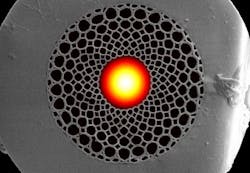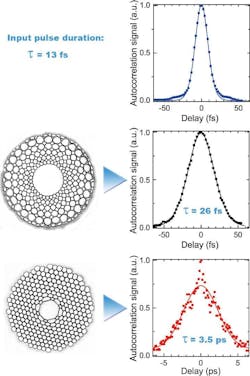FIBERS FOR FIBER LASERS: Chirped PC fibers break pulse-duration limits in femtosecond beam delivery
JENS BETHGE AND GÜNTER STEINMEYER
Femtosecond laser pulses are fragile light structures that are easily corrupted by linear or nonlinear optical effects in solid transparent media. The most prominent of these destructive effects is group velocity dispersion, which results from a dependence of the propagation velocity in an optical medium on wavelength. Group velocity dispersion eventually results in an increasing delay of the Fourier components constituting the short laser pulse. Another important effect is self-phase modulation, which causes a phase retardation of the more intense parts of a short laser pulse. Self-phase modulation typically results in spectral broadening, which enables subsequent pulse compression. However, direct and beneficial use of this process in fibers is restricted to the infrared region of the spectrum where short-wavelength components travel faster than do longer ones. At visible wavelengths, in contrast, excessive self-phase modulation increases dispersive broadening and may ultimately result in totally uncompressible pulse shapes. Given these optical effects, applications that require the use of ultrafast laser pulses at visible or near-infrared wavelengths tend to avoid relying on bulk optical media for pulse propagation.
Hollow fibers for beam delivery
As a result, fiber delivery of ultrafast pulses is generally considered difficult for sub-100 fs pulses. This situation is particularly unsatisfactory for delivery of Ti:sapphire oscillator pulses, with their nanojoule-level energy: such pulses immediately experience massive distortions from self-phase modulation when coupled into solid-core fiber. Recently though, photonic-crystal fibers with a hollow core have emerged and appear to offer an option for ultrafast pulse delivery because they essentially guide light through air, with little overlap with the surrounding photonic crystal structure.1, 2 Even though remarkably low losses of a few decibels per kilometer have been demonstrated with these fibers, they have been found unsatisfactory for sub-100 fs pulses because they do in fact strongly distort short pulses.
Photonic-crystal fibers typically use a cladding consisting of equally sized cells to accomplish confinement. Such a structure gives rise to sharp resonances, similar to the occurrence of peaks in x-ray diffraction analysis, yet with the Bragg condition occurring at visible or near-infrared wavelengths. The sharpness of these resonances is ultimately determined by the number of contributing resonant cells. It is important to note that spectral phase and absorption are intimately connected, leading to a strong increase of dispersive effects with an increased quality (Q) of the resonant structure. Additionally, photonic-crystal fibers with a periodic cladding exhibit strong third-order dispersion with little second-order dispersion, a combination that is very difficult to compensate for by material dispersion, prism and grating arrangements, or combinations thereof.
This third-order waveguide dispersion effect is strong and can easily exceed values equivalent to 10% of an equal length of bulk material. While third-order dispersion has little effect on picosecond pulses, its effect on sub-100 fs pulses is massive, causing strong dispersive broadening to picosecond durations after a single meter of propagation. As a result this type of dispersion has limited the practical use of hollow-core fibers for guiding sub-100 fs pulses.3
Chirped photonic-crystal fibers
One approach to avoid these detrimental effects is to actively spoil the quality of the resonance so as to decrease resonant enhancement, thus reducing detrimental dispersive effects at the expense of increased losses. This approach brings forth the idea of a chirped photonic-crystal fiber (see Fig. 1).4
Such a structure breaks with the unwritten law of equal cell sizes in photonic crystals and distributes resonances over a wide spectral range--because the resonances are distributed they cannot add up as they do in conventional photonic crystal fiber designs. Measurements of the resulting dispersion properties in comparison to properties of a microstructure fiber with periodic cladding clearly indicate a factor exceeding 100 in the resulting dispersion difference between the two structures. The dispersion characteristics of chirped photonic-crystal fibers resemble those of simple hollow-core capillaries but without exhibiting comparable losses.As a further test for the potential of chirped photonic-crystal fibers, 13 fs pulses from a Ti:sapphire oscillator were launched into conventional hollow fibers with strictly periodic cladding (Crystal Fibre HC 800-1) and their chirped counterparts (see Fig. 2).
While the chirped photonic-crystal fiber broadened the original pulse to only 26 fs after one meter of propagation, the HC800 fiber lengthened the pulse to several picoseconds, which clearly shows the superiority of the chirped-fiber approach for short lengths of fiber. Additionally, losses of the chirped fiber were slightly higher (5 dB/m), yet not prohibitively high compared to the unchirped photonic-crystal fibers. Thus, while chirped photonic-crystal fibers may currently not be capable of delivering short pulses over many meters of fiber, at distances up to about one meter the chirped-fiber concept shows a remarkably high fidelity in transporting pulses with little dispersive distortion, surpassing previous concepts by two orders of magnitude.
Toward applications
This remarkable improvement in delivering short pulses via fiber is certainly interesting for a number of applications. Spectroscopic applications in biology and medicine can benefit from nonlinear optical excitation mechanisms—a two-photon absorption, for instance, restricts the interaction between light and matter to a small focal volume. This enables control of the depth of the interaction zone and can be used beneficially in two-photon microscopy. While such experiments are often conducted on a regular optical table, it may be desirable to develop flexible fiber-based scanners that can provide a similar functionality—on the skin of a living human, for instance.
While diagnostic applications can be performed at moderate laser powers and appear feasible with large-mode-area fibers, difficulties increase for therapeutic application of intense femtosecond laser pulses. One such example is photodynamic therapy, in which a photosensitizer is enriched in cancerous tissue.5 In current applications, cells in the cancerous tissue are fatally damaged via one-photon activation of the photosensitizer. The selectivity of this process could be greatly improved with a depth-selective two-photon excitation mechanism. Several technical problems will certainly have to be solved before chirped photonic-crystal fibers can be integrated into catheters or endoscopes for therapeutic application of femtosecond laser pulses. Yet, with the successful demonstration of guiding sub-100 fs pulses through meter-long fiber, an avenue for previously impossible applications has been opened in medicine and biology.
While photodynamic therapy or applications of such fibers for two-photon microscopy and similar diagnostics benefit from the extremely small nonlinearity of this novel type of fiber, other applications may actually build on exploiting the optical nonlinearity of the gas inside the fiber. As one example, soliton formation has been demonstrated in hollow-core fibers with equal cell size.3 Chirped photonic-crystal fibers apparently offer exploitation of identical effects at much shorter pulse duration.
Current research on chirped photonic-crystal fibers targets further performance improvements of such structures, as losses of chirped fibers are still prohibitively large when pulse delivery over more than a few meters is required. Another important improvement is to further broaden the transmission bands, which currently limit the transmittable pulse duration to a lower value of some 20 fs. It remains to be seen how far the favorable dispersive properties can be maintained in such design optimizations. Nevertheless, even with the performance demonstrated so far, chirped photonic-crystal fibers are already an interesting new alternative when it comes to fiber-based delivery of sub-100 fs pulses. The possibility of delivering powerful pulses with short duration through a fiber clearly enables previously impossible applications.
ACKNOWLEDGMENT
The authors thank Julia S. Skibina (Saratov State University, Russia) and Valantin I. Beloglasov (Nanostructured Glass Technology, Saratov, Russia) for manufacturing chirped photonic-crystal fibers. They also gratefully acknowledge Rumen Iliew (Friedrich-Schiller-Universität Jena, Germany) and Sven Burger (Konrad-Zuse-Zentrum für Informationstechnik, Berlin, Germany) for modeling mode fields and propagation characteristics of such fibers.
REFERENCES
1. J. Knight, J. Broeng, T. Birks, and P. St. J. Russell, Science 282, p. 1476 (1998).
2. A. Bjarklev, J. Broeng, A. S. Bjarklev, Photonic Crystal Fibres (Kluwer, 2003).
3. F. Luan et al., Opt. Express 12, p. 835 (2004).
4. J. S. Skibina, R. Iliew, J. Bethge, M. Bock, D. Fischer, V. I. Beloglasov, R. Wedell, and G. Steinmeyer, Nature Photonics 2, p. 679 (2008).
5. J. Bethge, G. Steinmeyer, S. Burger, F. Lederer, R. Iliew, IEEE J. Lightwave Technol. 27, p. 1698 (2008).
6. C. Xu, W. Zipfel, J. B. Shear, R. M. Williams, W. M. Webb, Proc. Natl Acad. Sci. USA 93, p. 10763 (1996).
Jens Bethge is a Ph.D. student at the Max Born Institute for Nonlinear Optics and Short-Pulse Spectroscopy in Berlin, Germany. Günter Steinmeyer is a senior researcher at the same Institute; e-mail: [email protected]; www.mbi-berlin.de.

